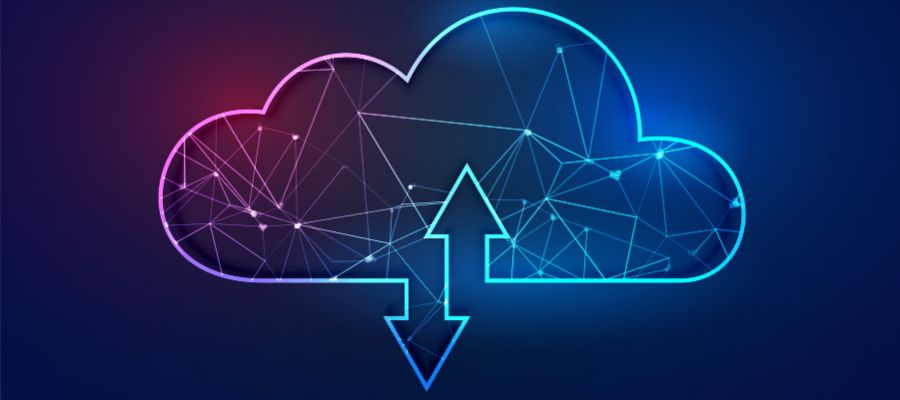4 Different Types of Cloud Computing Services

Cloud computing is a revolutionary change in this digital-drive marketplace. Modern enterprises are embracing this advanced technology and its services to remain competitive.
It provides them with secure access, security, and countless other benefits. IT professionals are moving away from traditional services to cloud services as it gives them access to advanced tools and solutions.
This blog explains the different types of cloud computing services with examples that allow concerned professionals to make a reasonable choice.
Table Of Content
Different Types of Cloud Computing Services
Infrastructure as a Service (IaaS)
IaaS is one of the primary cloud computing models providing internet computer resources. It consists of virtual servers, storage, networking, and operating systems.
It allows consumers to rent out computer resources that are virtualized from the internet instead of physically owning and maintaining them.
The initial cost of hardware and software is avoided; management becomes easier while scalability is offered on demand.
Benefits
- Affordability: The on-demand pricing system eliminates upfront spending on hardware and makes budgeting easy.
- Elasticity: Grow or lessen resources depending on your needs at any given time.
- Speed and Creativity: Rapid creation and deployment of new applications and environments facilitated.
- Quick Recovery: The disaster recovery services ensure fast restoration processes and minimize downtimes during failures.
Use cases for IaaS include
- Hosting websites and applications
- Running large-scale data analytics workloads
- Building and managing virtual desktops
- Developing and testing new applications
Platform as a Service (PaaS)
SaaS is one of the well-liked cloud services that deliver pre-built application software. It has a straightforward approach.
SaaS providers manage all of the application infrastructure and software so that the software you are using by the client is kept up to date and includes significant new features, including security patches, without clients having to run their side of the installation or support hurriedly.
Advantages and Applications
- Faster development and deployment: A streamlined development environment fosters more rapid application creation and deployment.
- Simplification: Infrastructure management is more accessible so developers can concentrate more on writing codes.
- Scalable with Flexible Nature: Resources can be scaled up or down quickly to cope with changing requirements.
PaaS finds application in various scenarios, including
- Building and deploying web applications
- Developing mobile applications
- Creating microservices architectures
- Running data analytics and machine learning workloads
Software as a Service (SaaS)
SaaS is one of the well-liked cloud services that deliver pre-built application software. It has a straightforward approach.
SaaS providers manage all of the application infrastructure and software so that the software you are using by the client is kept up to date and includes significant new features, including security patches, without clients having to run their side of the installation or support hurriedly.
Pros of using SaaS
- Cost-effective: Subscription models are pay-as-you-go, and you no longer have to invest vast amounts of money in software costs. It also suggests cost-effective budgeting.
- Scalability and ease of use: Providing your staff subscriptions to use this software as needed is straightforward, often just with one more login.
- Automatic updates: You will receive automated access to new features without worrying about them.
Cons
- Limited customization: Less flexibility in customizing software behavior compared to on-premise solutions.
- Vendor lock-in: Reliance on a specific vendor can lead to difficulties if switching to another provider.
- Internet dependency: Reliant on a reliable internet connection for application access.
Function as a Service (FaaS)
FaaS helps developers create, operate, and monitor application packages. It has emerged as a cloud service where developers upload snippets of code (or functions) and are freed from having to provision servers, let alone run server operating systems and runtime environments.
Developers write the code, and the FaaS provider handles everything else, including scaling, provisioning, and maintaining the environment.
This enables rapid development and deployment of event-driven applications with minimal infrastructure management overhead.
Benefits of Implementing FaaS
- Cost efficiency: Pay only for the resources used, which is ideal for running short-lived or event-driven applications.
- Faster development and deployment: Enables rapid development and deployment of serverless applications.
- Reduced operational burden: Eliminates server management and infrastructure complexities.
FaaS is ideal for developing
- Serverless applications
- APIs and microservices
- Data processing and analysis workflows
Factors to Consider When Selecting a Cloud Computing Service
A top-of-the-line managed IT service is essential for a company’s technology, safety, and success. Services and features vary among providers, so making a wise choice is crucial.
Here are some things to think about when picking a service provider with advanced features of cloud computing:
Safety and Following Rules
Data safety and following rules are paramount. Check the provider’s safety measures, like how they keep data safe and who can access it.
Ensure they follow the data privacy and security rules that apply to your company.
Services and Flexibility
Decide what kinds of clouds you need, like infrastructure, platform, or software. Work with providers who offer diverse types of managed services from start to end.
Check if the provider can easily adjust resources for your changing needs.
Prices and Saving Money
Cloud services can save a lot of money compared to regular systems. But it’s essential to understand how the provider charges for their services.
Look at paying as you use or getting cost savings for long-term use. Be careful about extra fees and know the total cost before you choose.
Integration and Migration Considerations
Integration and migration should also include your cloud services so you can still easily control these and integrate them with your IT infrastructure and applications.
Look for cloud services with which the provider offers migration help that lightens the load transitioning from on-premises systems to the cloud.
Vendor Lock-in and Exit Strategy
Vendor lock-in is a problem that can occur if moving to a new cloud provider becomes difficult because of proprietary data formats or APIs.
Select a provider that employs open standards and provides tools to make your data portable, letting you move to another provider if necessary.
Customer Support and Reputation
Evaluate the provider’s customer support offerings, including availability, response times, and support channels.
Look for providers with a strong reputation for responsive and knowledgeable support teams.
Reviewing customer reviews and project testimonials can give a fair idea of the user experience and potential challenges.
Contact STM IT Solutions Today for a Consultation
Finding the right service provider can be long-delayed and exhaustive. The key to successful cloud implementation is overcoming this challenge with Managed IT services.
If you are ready to power your IT infrastructure with reliable solutions, consider IT Support Company as your destination for cutting-edge solutions.
Our team of certified cloud experts will conduct a consultation to assess your needs and recommend tailored cloud solutions to optimize your infrastructure, enhance security, and empower your digital journey. Contact us today and take your business to the next level.
FAQs
Prioritize data encryption, implement robust access controls, leverage multi-factor authentication, regularly update security measures, and choose reputable cloud providers with stringent compliance standards for comprehensive security.
Plan a migration strategy, assess compatibility, use reliable tools, back up data, and conduct thorough testing. Consider phased migration to minimize disruptions and ensure a seamless transition to the cloud.
PaaS streamlines development by offering pre-configured platforms, reducing time-to-market, enhancing collaboration, and allowing developers to focus solely on coding. It provides a scalable and cost-effective solution for efficient application development.
Cloud computing facilitates real-time collaboration through centralized data access. It enables remote work by providing secure and flexible access to applications and data, fostering seamless communication and collaboration among distributed teams.
Begin your consultation with STM IT Solutions by contacting us through our website or providing contact information. Engage with our experts to discuss your specific IT needs and objectives. Our team will guide you through tailored solutions to enhance your technological infrastructure.
Get In Touch
Also Read

